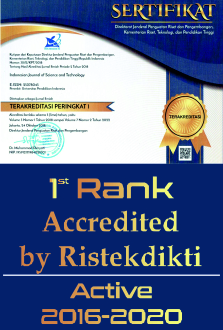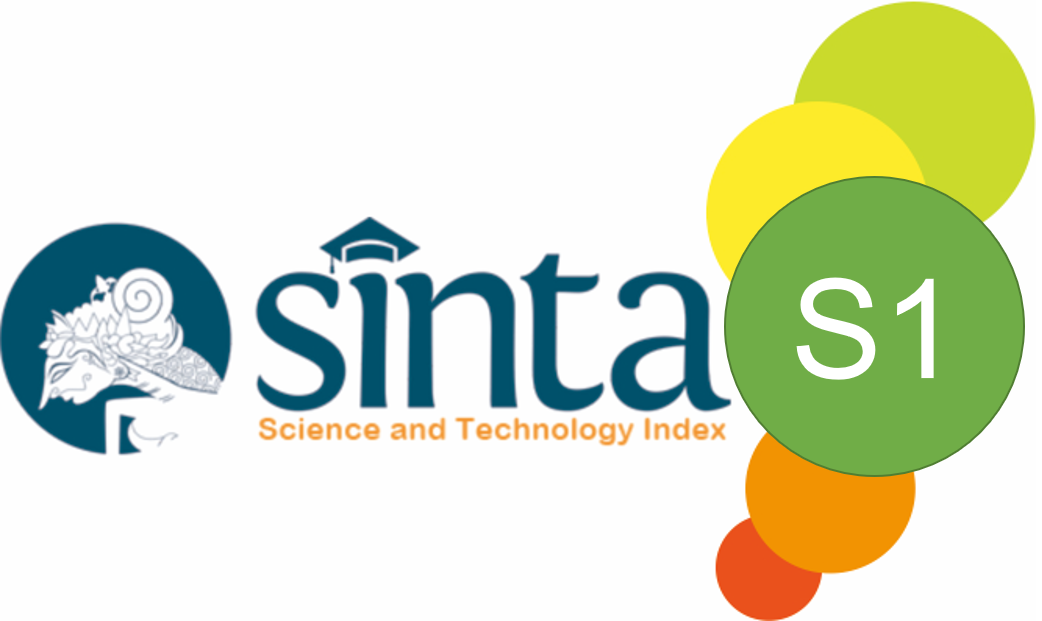Synthesis and Application of a Sulfonated Carbon Catalyst for a Hydrolisis Reaction
Abstract
Biomass, such as wood waste, is one of the resources that can be potentially converted into a carbon product for catalyst applications. In this study, the sulfonated carbon was obtained through the pyrolysis method for wood waste at the temperature of 350°C, which was later sulfonated through the use of H2SO4 (8N) on the reflux for 4 h. The sulfonated carbon was then analyzed and characterized including its water content, ash content, volatile matter, fixed carbon, iodine adsorption as well as the H+ (acidity) capacity using ammonia adsorptions and functional groups and the Fourier Transform Infra-Red (FTIR) instrument. The catalyst application was carried out during the kempili pulp hydrolysis process using a microwave with the ratio of catalyst to a pulp of 1:1 (5g:5g), with the power conditions of 300, 400, and 600 watt for 3, 5, and 7 min. The results showed that the sulfonated carbon catalyst had water content, volatile matter, ash content, fixed carbon, iodine adsorption as well as the catalyst acidity as much as 3.48%; 11.70%; 4.21%; 84.62%; 690.88 mg/g; and 6.45 mmol/g, respectively with the highest glucose content of 160.83 ppm. The carbon-based catalyst is expected as an alternative catalyst, can be further developed for hydrolysis reactions, and can serve as a green technology product in the future.
Keywords
Full Text:
PDFReferences
Amelia, R., Pandapotan, H., and Purwanto. (2013). Proses hidrolisis biomassa. Jurnal Teknologi Kimia dan Industri, 2(4), 146–156.
Anggoro, D. D., Rispiandi, and Purwanto. (2015). Hydrolysis of Eichhornia crassipes to glucose over sulfonated active carbon catalyst. Malaysian Journal of Fundamental and Applied Sciences, 11(2), 67–69.
Anggraeni, P., Addarojah, Z., and Anggoro, D. D. (2013). Hidrolisis selulosa eceng gondok (Eichhornia crassipe) menjadi glukosa dengan katalis arang aktif tersulfonasi. Jurnal Teknologi Kimia Dan Industri, 2(3), 63–69.
Chen, W., Tu, Y., and Sheen, H. (2011). Disruption of sugarcane bagasse lignocellulosic structure by means of dilute sulfuric acid pretreatment with microwave-assisted heating. Applied Energy, 88, 2726–2734.
do Couto Fraga, A., Quitete, C. P. B., Ximenes, V. L., Sousa-Aguiar, E. F., Fonseca, I. M., & Rego, A. M. B. (2016). Biomass derived solid acids as effective hydrolysis catalysts. Journal of Molecular Catalysis A: Chemical, 422, 248-257.
Erawati, E., and Fernando, A. (2018). Pengaruh jenis aktivator dan ukuran karbon aktif terhadap pembuatan adsorbent dari serbuk gergaji kayu sengon (Paraserianthes falcataria). Jurnal Integrasi Proses, 7(2), 58–66.
Goswami, M., Meena, S., Navatha, S., Rani, K. N. P., Pandey, A., Sukumaran, R. K., and Devi, B. L. A. P. (2015). Hydrolysis of biomass using a reusable solid carbon acid catalyst and fermentation of the catalytic hydrolysate to ethanol. Bioresource Technology, 188, 99–102.
Guo, F., Fang, Z., Xu, C. C., & Smith Jr, R. L. (2012). Solid acid mediated hydrolysis of biomass for producing biofuels. Progress in Energy and Combustion Science, 38(5), 672-690.
Hu, L., Lin, L., Wu, Z., Zhou, S., and Liu, S. (2015). Chemocatalytic hydrolysis of cellulose into glucose over solid acid catalysts. Applied Catalysis B, Environmental, 174, 225–243.
Khuluk, R.H., Rahmat, A., Buhani., and Suharso. 2019. Removal of methylene blue by adsorption onto activated carbon from coconut shell (Cocous Nucifera L.). Indonesian Journal of Science and Technology, 4(2), 229-240
Kumar, V. B., Pulidindi, I. N., and Gedanken, A. (2015). Selective conversion of starch to glucose using carbon based solid acid catalyst. Renewable Energy, 78, 141–145.
Lacerda, T. M., Zambon, M. D., and Frollini, E. (2015). Oxalic acid as a catalyst for the hydrolysis of sisal pulp. Industrial Crops and Products, 71, 163–172.
Lestari, K. D., Ratnani, R. D., Suwardiyono, and Kholis, N. (2017). Pengaruh waktu dan suhu pembuatan karbon aktif dari tempurung kelapa sebagai upaya pemanfaatan limbah dengan suhu tinggi secara pirolisis. Inovasi Teknik Kimia, 2(1), 32–38.
Li, S., Gu, Z., Bjornson, B. E., and Muthukumarappan, A. (2013). Biochar based solid acid catalyst hydrolyze biomass. Journal of Environmental Chemical Engineering, 1, 1174–1181.
Marzo, M., Gervasini, A., and Carniti, P. (2012). Hydrolysis of disaccharides over solid acid catalysts under green conditions. Carbohydrate Research, 347(1), 23–31.
Miller, G. L. (1959). Use of DinitrosaIicyIic acid reagent for determination of reducing sugar. Analytical Chemistry, 31(3), 426–428.
Morales-delaRosa, S., Campos-Martin, J. M., & Fierro, J. L. (2018). Chemical hydrolysis of cellulose into fermentable sugars through ionic liquids and antisolvent pretreatments using heterogeneous catalysts. Catalysis Today, 302, 87-93.
Nandiyanto, A.B.D., Oktiani, R., and Ragadhita, R. 2019. How to read and interpret FTIR spectroscope of organic material. Indonesian Journal of Science and Technology, 4(1), 97-118
Nandiyanto, A. B. D., Putra, Z. A., Andika, R., Bilad, M. R., Kurniawan, T., Zulhijah, R., and Hamidah, I. (2017). Porous activated carbon particles from rice straw waste and their adsorption properties. Journal of Engineering Science and Technology, 12, 1-11.
Nata, I. F., Irawan, C., Mardina, P., and Lee, C. (2015). Carbon-based strong solid acid for cornstarch hydrolisis. Journal of Solid State Chemistry, 230, 163–168.
Ormsby, R., Kastner, J. R., and Miller, J. (2012). Hemicellulose hydrolysis using solid acid catalysts generated from biochar. Catalysis Today, 190(1), 89–97.
Pari, G., Sofyan, K., Syafii, W., Buchari, and Yamamoto, H. (2006). Kajian struktur arang dan lignin. Jurnal Penelitian Hasil Hutan, 24(1), 9–20.
Purwanto, D. (2011). Arang dari limbah tempurung kelapa sawit (Elaeis guneensis Jacq). Jurnal Penelitian Hasil Hutan, 29(1), 57–66.
Putra, Z.A. (2018). Lignocellulosic biomass pretreatment for biorefinery: A review. Indonesian Journal of Science and Technology, 3(1), 75-81
Qi, X., Yan, L., Shen, F., and Qiu, M. (2018). Mechanochemical-assisted hydrolysis of pretreated rice straw into glucose and xylose in water by weakly acidic solid catalyst. Bioresource Technology, 273, 687–691.
Qu, H., Zhou, Y., Ma, Y., Zhao, P., Gao, B., Guo, M., and Feng, C. (2018). A green catalyst for hydrolysis of cellulose : Amino acid protic ionic Liquid. Journal of the Taiwan Institute of Chemical Engineers, 93, 667–673.
Radhakumari, M., Ball, A., Bhargava, S. K., and Satyavathi, B. (2014). Optimation of glucose formation in karanja biomass hydrolisis using taguchi robust method. Bioresources Technology, 166, 534–540.
Rinaldi, R., Meine, N., Stein, J. vom, Palkovits, R., and Schüth, F. (2010). Which Controls the Depolymerization of Cellulose in Ionic Liquids : The Solid Acid Catalyst or Cellulose ? Chem Sus Chem, 3, 266–276.
Sahara, E., Sulihingtyas, W. D., and Mahardika, I. P. A. S. (2017). Pembuatan dan karakterisasi arang aktif dari batang tanaman gumitir (Tagetes erecta) yang diaktivasi dengan H3PO4. Jurnal Kimia, 11(1), 1–9.
Setyawan, M. N., Wardani, S., and Kusumastuti, E. (2018). Arang kulit kacang tanah teraktivasi H3PO4 sebagai adsorben ion logam Cu (II) dan diimobilisasi dalam bata beton. Indonesian Journal of Chemical Science, 7(3), 262–269.
Shen, S., Wang, C., Cai, B., Li, H., Han, Y., Wang, T., and Qin, H. (2013). Heterogeneous hydrolysis of cellulose into glucose over phenolic residue-derived solid acid. Fuel, 113, 644–649.
Suganuma, S., Nakajima, K., Kitano, M., Yamaguchi, D., Kato, H., Hayashi, S., and Hara, M. (2008). Hydrolysis of cellulose by amorphous carbon bearing SO3H, COOH, and OH groups. J Am Chem Soc, 130(38), 12787–12793.
Sun, B., Duan, L., Peng, G., Li, X., and Xu, A. (2015). Efficient production of glucose by microwave-assisted acid hydrolysis of cellulose hydrogel. Bioresources Technology, 192, 253–256.
Thoha, M. Y., and Fajrin, D. E. (2010). Pembuatan briket arang dari daun jati dengan sagu aren sebagai pengikat. Jurnal Teknik Kimia, 17(1), 34–43.
Tong, D. S., Xia, X., Luo, X. P., Wu, L. M., Lin, C. X., Yu, W. H., and Zhong, Z. K. (2013). Catalytic hydrolysis of cellulose to reducing sugar over acid-activated montmorillonite catalysts. Applied Clay Science, 74, 147–153.
Wibowo, S., Syafii, W., and Pari, G. (2011). Karakterisasi permukaan arang aktif tempurung biji Nyamplung. Makara Teknologi, 15(1), 17–24.
DOI: https://doi.org/10.17509/ijost.v5i3.25275
Refbacks
- There are currently no refbacks.
Copyright (c) 2020 Indonesian Journal of Science and Technology

This work is licensed under a Creative Commons Attribution-ShareAlike 4.0 International License.
Indonesian Journal of Science and Technology is published by UPI.
View My Stats





















